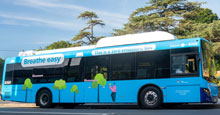
Be Bus Aware
Be Bus Aware
Our annual Bus Safety Week raises awareness among all road users on how to stay safe on and around buses, helping to reduce injuries and fatalities.
Buses are large, heavy vehicles and can’t stop quickly.
Image
Image controls:
Image
Image controls:
Image
Image controls:
Millions of trips
Almost 4000 buses operate in the Sydney area, while another 1000 buses service the Newcastle, Wollongong and Blue Mountains areas. Also, more than 3000 bus services operate in rural and regional NSW.
Pedestrians make-up almost half of all fatalities from bus crashes.
Since 2018* there were 48 fatalities from bus crashes (including mini buses) in NSW. Of the 48 fatalities, 15 people were pedestrians, 8 were drivers (of vehicles other than a bus), 7 were motorcyclists, 4 were bus drivers, 11 were bus passengers, 2 were passengers (of vehicles other than a bus), and 1 was a pedal cyclist.
* Data as at up to midnight on 29 November 2023.
Pedestrians
Bus Safety Week promotes safety for pedestrians, who should:
- plan ahead and don't rush for the bus
- obey traffic signals and cross with care
- avoid being distracted by mobile devices
- stand back from the kerb when waiting for a bus
- wait until the bus has gone then use a safe place to cross the road.
Parents and carers
School-aged children might seem independent, but they still need a hand.
Remember:
- Always meet your child at school or the bus stop. Never wait on the opposite side of the road and call them across.
- Always supervise your child and hold their hand when walking to and from the bus stop/interchange and when crossing the road until they're at least 10 years old.
- Wait until the bus has gone then use a safe place to cross the road.
- Encourage your child to take a seat quickly when they get on the bus and to buckle up if the bus has seatbelts.
Talk to your children about using Stop! Look! Listen! Think! every time they cross the road.
- Stop one step back from the kerb.
- Look continuously both ways.
- Listen for the sounds of approaching traffic.
- Think whether it's safe to cross and keep checking until you're safely across.
Zero emission buses

Our zero emission buses are helping us achieve our climate change goals. They're much quieter and reduce noise pollution, so remember to always stay alert when you're walking around buses and traffic.
Image
Image controls:
Image
Image controls:
Image
Image controls:
Image
Image controls:
Image
Image controls:
Drivers
We know that because of their large size and mass, buses cause severe outcomes for other road users in crashes. Buses can't stop quickly, so drivers should:
- give way to buses
- not merge too closely in front of buses
- keep a safe distance from buses in front of you
- slow down to 40km/h when bus lights are flashing, unless a lower speed limit applies
- be aware of a bus’s blind spots at the front, rear and sides of the bus.
Bicycle riders
- If you're overtaking a bus, avoid passing it when it's turning – buses can take up more than one lane when they turn
- Be aware of a bus’s blind spots at the front, rear and sides of the bus
- You may travel in a Bus Lane, Tram Lane, Transit Lane or Truck Lane but not in a Bus Only Lane
- Follow the rules and ride with care.
Passengers
All bus passengers should:
- press the button well before your stop to give the driver plenty time to stop safely
- wait until the bus has stopped before you get out of your seat
- buckle up if the bus has seatbelts.
If you're older, have a disability or are pregnant, try to sit closer to the front of the bus or in a courtesy seat and use the front doors, which can be lower and closer to the kerb.
Motorcycle riders
When riding a motorcycle, you need to take extra care near buses. Follow these helpful tips to keep you safe around buses:
- Be aware of a bus’s blind spots at the front, rear and sides of the bus
- Avoid lane filtering near buses
- Buses may be longer than expected. Take care when changing lanes around buses.
- Avoid trying to overtake a bus when it is turning. Buses need extra space and may take up more than one lane.
- Always follow the road rules and ride with care.
Bus safety for children
Bus safety for school students has more information on how families can help keep children safe getting on and off buses.
The Safety Town website has activities you can do with primary school children to help them stay safe on and around buses. There's also a section for families on driving safely around buses, and getting children to and from the bus stop safely.
Our Agent Walker: Operation Safe Transit bus safety video was produced for school students in years 5 and 6, who are starting to gain independence, and their teachers, parents and carers.
Working together
Bus flashing lights
Drivers should look out for children who are crossing the road or waiting to cross. Lights flash on buses to warn motorists that buses are picking up and dropping off children.
By law, a driver must not overtake or pass a bus with flashing lights at more than 40km/h.
Lights begin to flash when the bus stops and the doors open, and they keep flashing for about 20 seconds after the doors close. Children are most at risk in the minutes after they get off the bus.
Young children are often unpredictable in their movements. They are still developing the skills that help them to judge the direction of sound and the speed and distance of vehicles.
Due to their large size and mass, buses can cause severe outcomes for other road users in crashes. Motorists can help reduce the risk of a crash and keep children safe by:
- slowing down to 40km/h when bus lights are flashing, unless a lower speed limit applies
- looking out for children crossing the road near bus stops, in school zones or along bus routes
- giving way to buses when they merge back into traffic.
Image
Image controls:
Image
Image controls:
Image
Image controls:
Parents and carers
School-age children might seem independent, but they still need a hand. Remember:
- Always meet your child at school or the bus stop. Never wait on the opposite side of the road and call them across.
- Always supervise your child and hold their hand when walking to and from the bus stop/interchange and when crossing the road until they are at least 10 years old
- Wait until the bus has gone then use a safe place to cross the road
- Encourage your child to take a seat quickly when they get on the bus and to buckle up if the bus has seatbelts.
Talk to your children about using Stop! Look! Listen! Think! every time they cross the road:
- Stop one step back from the kerb
- Look continuously both ways
- Listen for the sounds of approaching traffic
- Think whether it is safe to cross and keep checking until safely across.
Informal school bus stops – rural and regional areas
In rural and regional areas there are many informal school bus stops that don't have signs or structures, such as bus shelters. They're often temporary and located at the end of a driveway or residence. Slow down to 40km/h when bus lights flash and look out for children crossing the road. A stationary bus can block the view of children, so drivers need to slow down.
Parents and carers also play an important role in ensuring the safety of students around school bus stops. If your child needs to use a rural bus stop that doesn’t have signs or safety infrastructure – think about whether it’s in a safe location that allows buses to stop away from the road, with good lines of sight in both directions, and includes a safe place for you to park your vehicle and wait. Talk to your local bus operator or find more information in our Advice for Choosing Locations of Informal School Bus Stops (PDF, 104.48 KB).
Image
Image controls:
Image
Image controls:
Working together
Our bus safety campaigns been developed with input from the State Transit Authority, Bus NSW and the NSW Police Force. The Department of Education, the Catholic Education Commission, the Association of Independent Schools and the Kids and Traffic Early Childhood Road Safety Education Program at Macquarie University also support Be Bus Aware and Bus Safety Week.
For more information
Safety around schools
Transport for NSW, local councils, NSW police, school principals and school communities work together to manage safety around schools.



